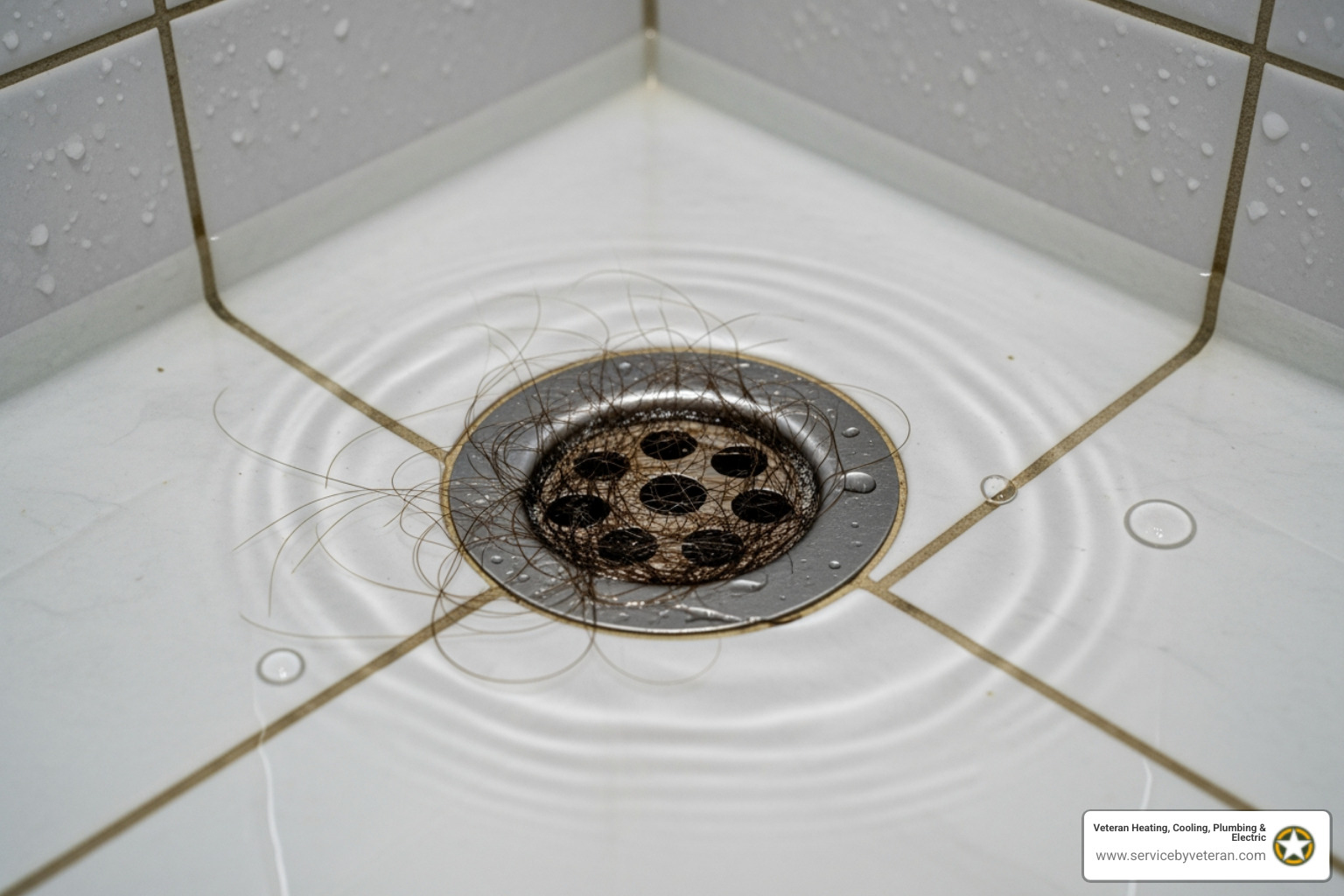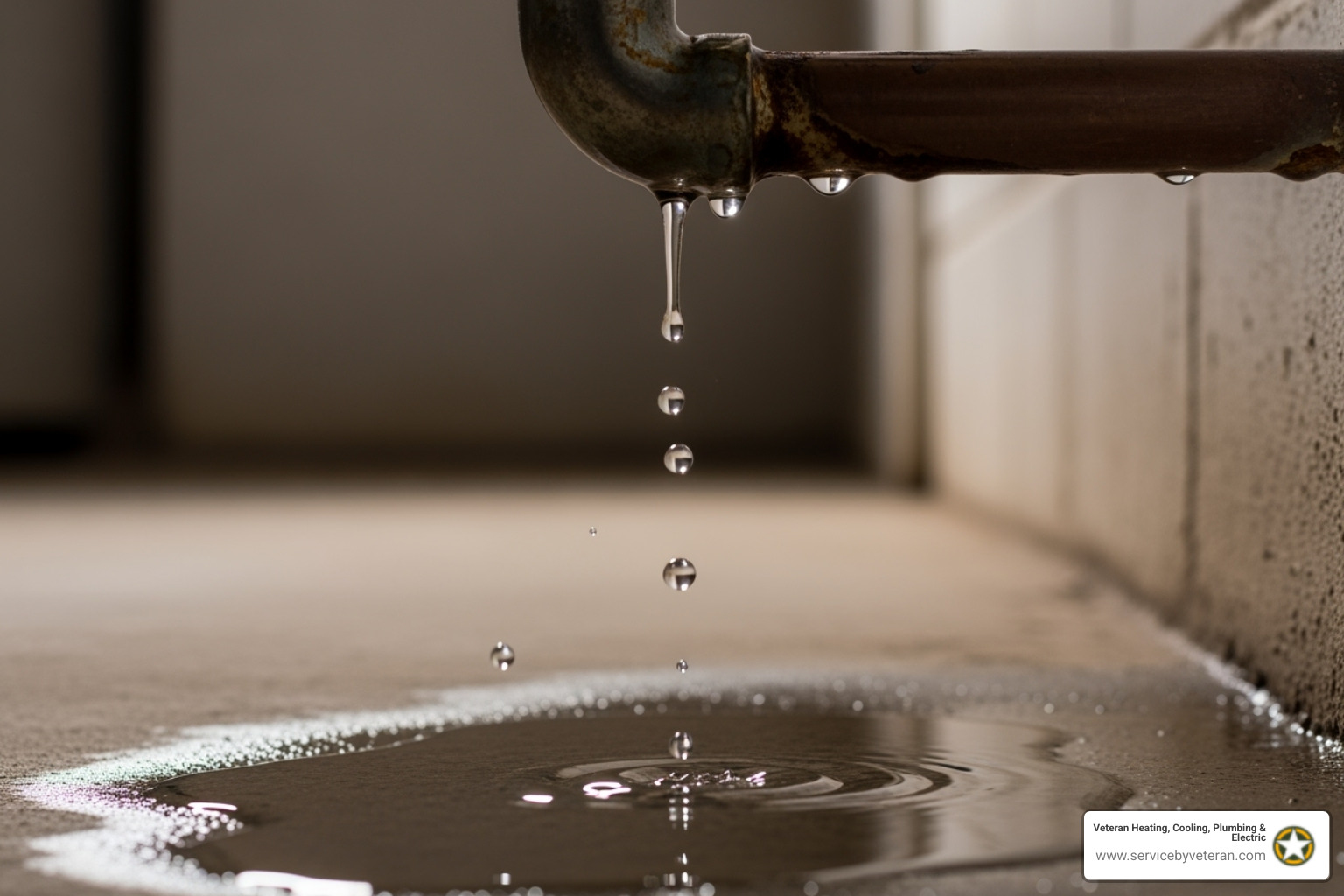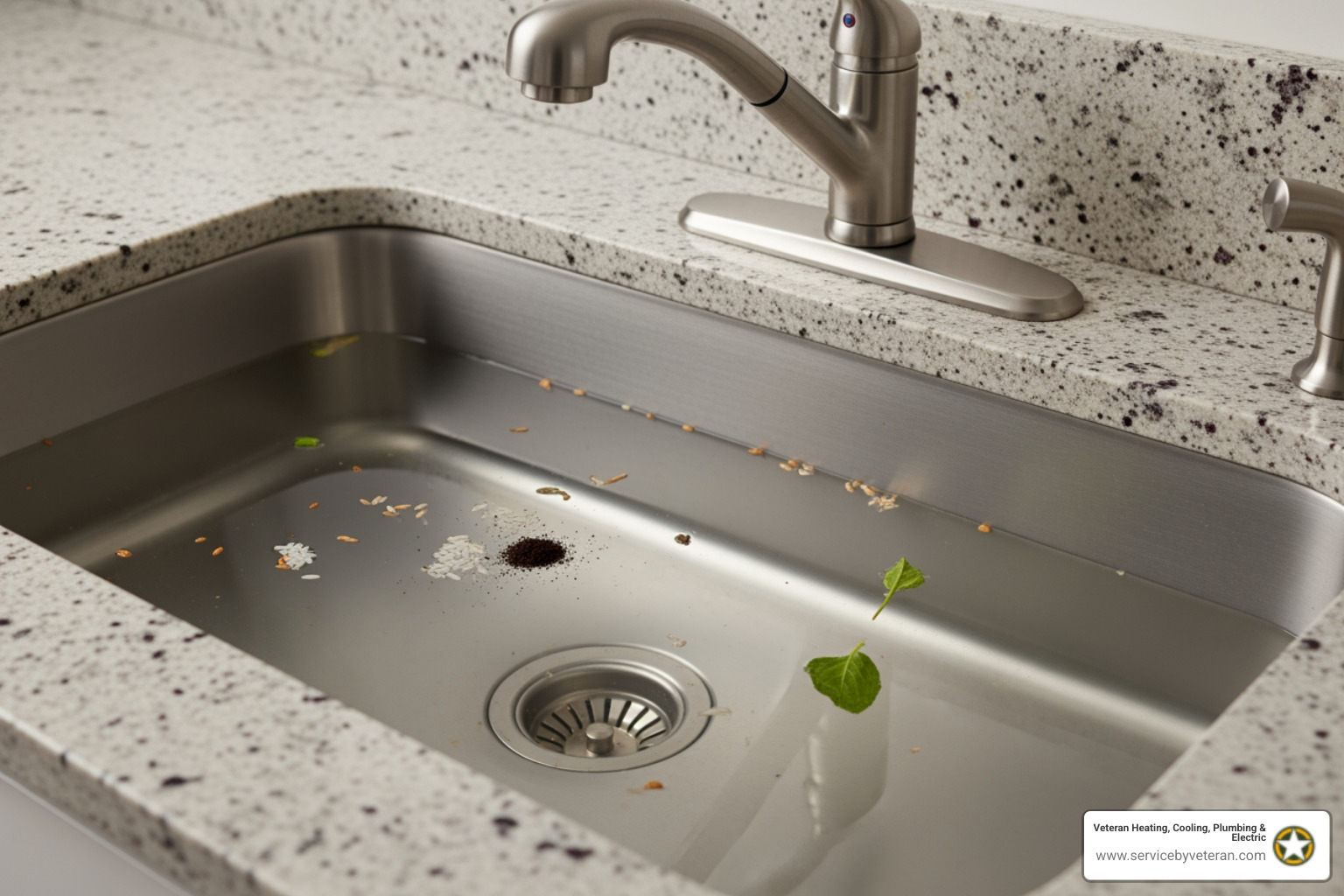When Your Furnace Needs a Fresh Start
Furnace replacement is necessary when your heating system no longer provides comfortable, safe, and affordable heat. This decision often comes when a furnace is 15-20 years old, needs frequent repairs, or causes high energy bills.
Key indicators you need furnace replacement:
- Age: 15+ years old with frequent repairs
- Cost: Energy bills increased 20-30% without usage changes
- Performance: Uneven heating, strange noises, or constant cycling
- Safety: Yellow pilot light, rust, cracks, or carbon monoxide concerns
- Efficiency: AFUE rating below 80% on older units
The average cost for complete furnace replacement ranges from $2,825 to $6,846, with most homeowners paying around $4,771. Natural gas systems typically cost $3,800-$10,000, while electric units range from $2,000-$7,000.
Best times to replace:
- Spring or summer for better scheduling and potential savings
- Before an emergency breakdown during winter
- When repair costs exceed 50% of the replacement cost
I'm Mike Townsend. My U.S. Army experience managing precision cooling systems taught me the importance of detail and safety. After eight years of service, I founded Veteran Heating, Cooling, Plumbing & Electric to bring that same military precision to furnace replacement for Denver-area homeowners.
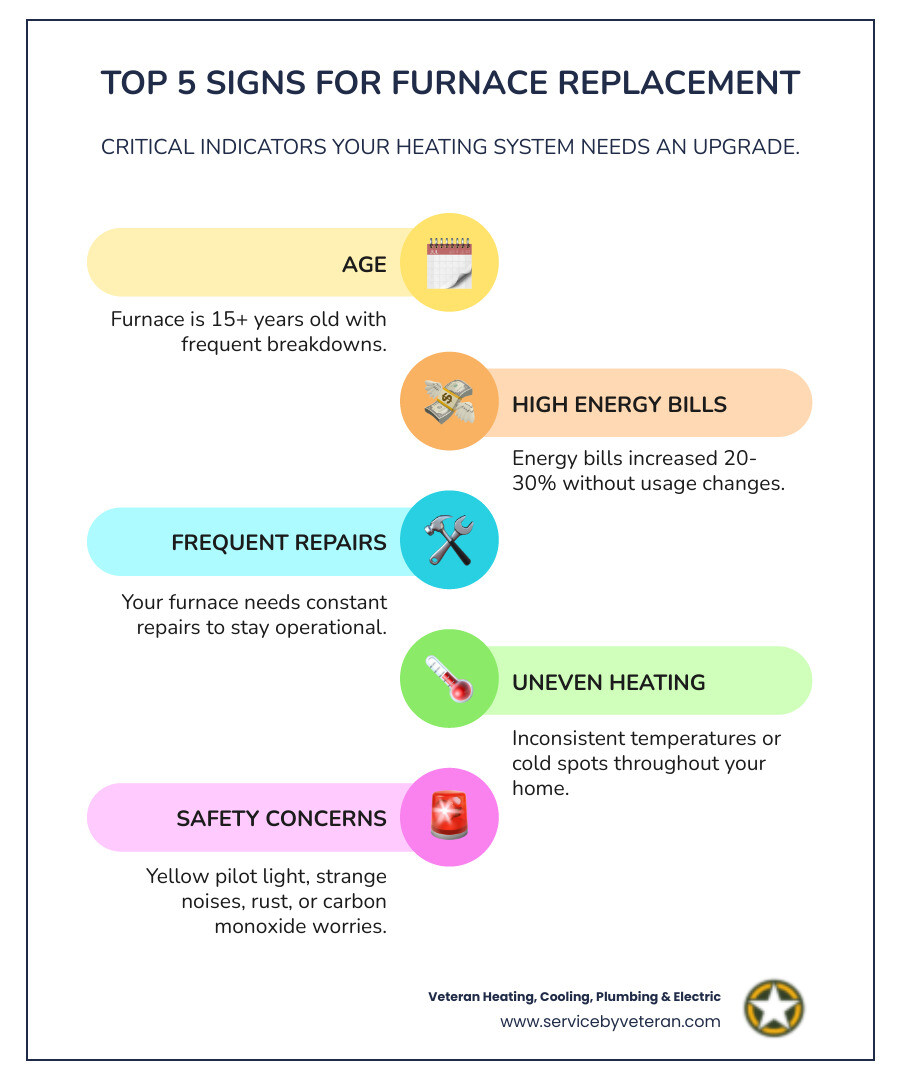
Is It Time for a Furnace Replacement?
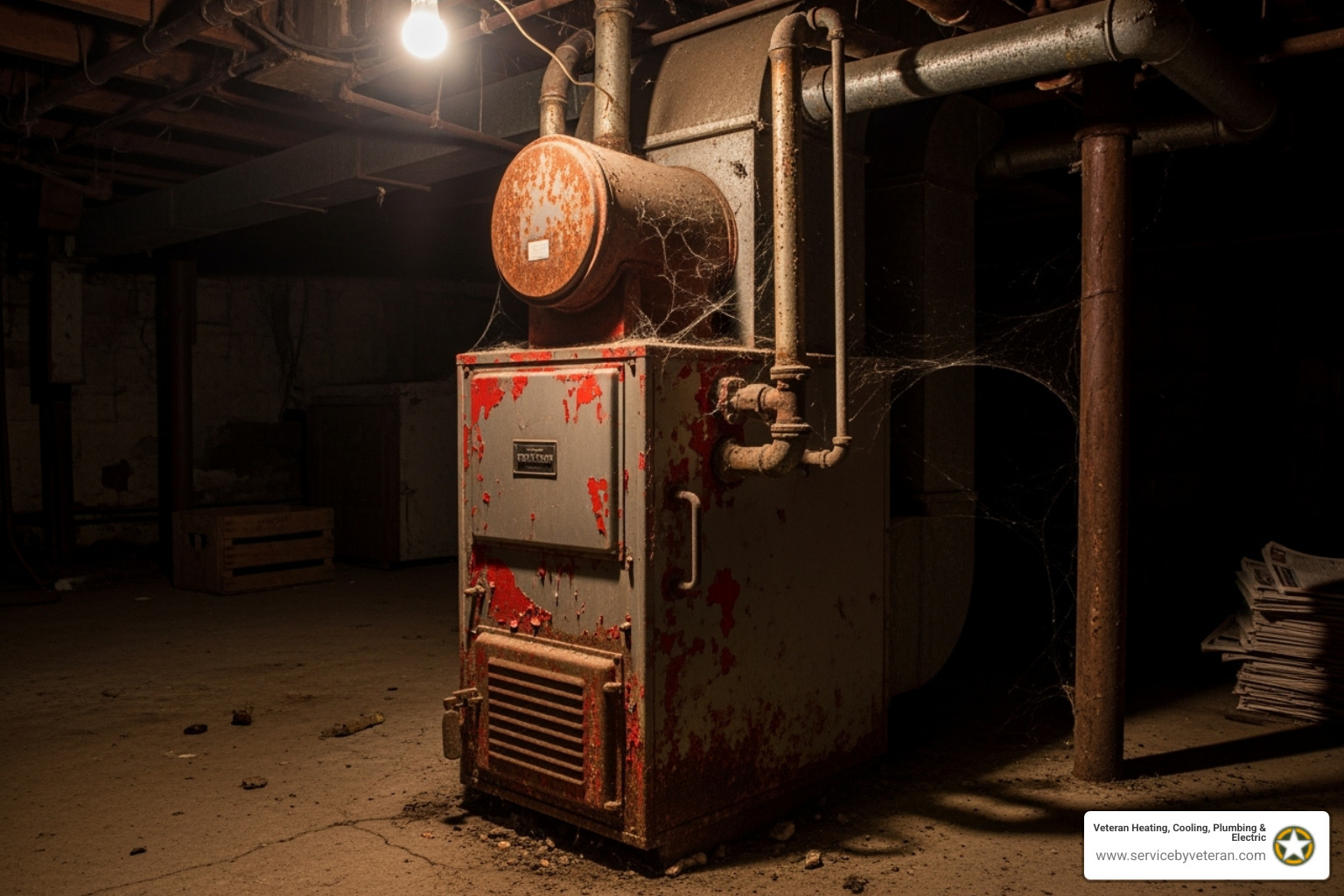
If your furnace is struggling through another Denver winter, you may wonder if it's time for a replacement. There's a point where repairs cost more than a new unit, which for furnaces is often at the 15 to 20-year mark.
Most furnaces are built to last about two decades. While some well-maintained units last longer, efficiency drops and repair needs increase after 15 years. Safety also becomes a major concern with aging furnaces. The carbon monoxide risk is the most serious issue, as older units can develop cracked heat exchangers that leak this deadly, odorless gas. A yellow pilot light, instead of a blue one, is a critical warning sign. If you see a yellow flame, call a professional immediately, as it indicates incomplete combustion and potential carbon monoxide production.
Telltale Signs Your Furnace is Failing
Your furnace usually provides warnings before it fails completely.
- Increased energy bills are a primary red flag. If costs jump 20-30% without a change in usage, your furnace is losing efficiency.
- Strange noises like banging, clanking, or grinding signal serious issues such as worn bearings or loose parts.
- Uneven heating is another clear sign of failure. If some rooms are hot while others are cold, your furnace is struggling to distribute heat.
- Visible rust or cracks around the unit, especially near the heat exchanger, are serious safety hazards.
- Frequent cycling, where the furnace turns on and off constantly or runs for hours without heating properly, indicates a problem.
- Increased dust and soot around vents or strange odors can point to dirty burners or other internal issues affecting air quality.
Repair or Replace? Making the Right Financial Decision
The 50% rule is a helpful guideline: if a repair costs 50% or more of a replacement, it's usually smarter to replace, especially if the unit is over 15 years old and has needed multiple repairs.
Consider the age of your unit and the frequency of breakdowns. A single repair on a newer furnace is logical, but multiple service calls on an aging system add up. Even after repairs, an older furnace will consume more energy than a modern high-efficiency model.
For immediate issues, you can find more info about furnace repair services. However, future energy savings from a new furnace often offset the upfront investment within a few years. We provide honest assessments and transparent pricing for both options to help you make the most cost-effective decision.
Choosing Your New Furnace: A Buyer's Guide
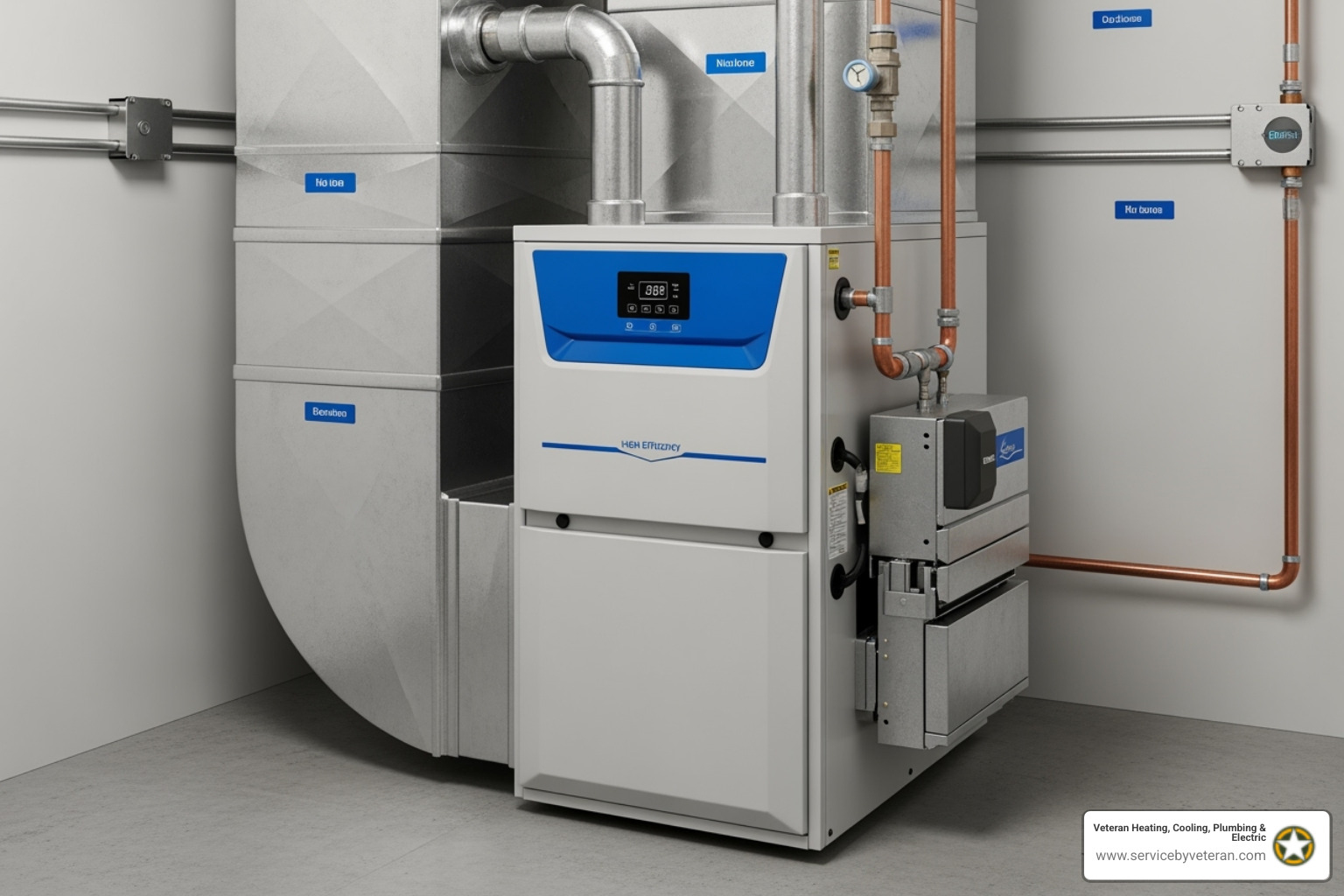
Choosing a new furnace is a key step toward improving your home's comfort and efficiency. The right system must be custom to your home's specific needs. Modern high-efficiency furnaces work smarter, keeping your home comfortable while shrinking your energy bills. Beyond reliable heat, you'll benefit from lower utility costs as more fuel is converted into warmth. Additionally, government rebates and incentives are often available for high-efficiency systems, and we can help you steer these opportunities.
Types of Furnaces: Pros and Cons
Choosing the right fuel type for your furnace replacement depends on local availability and your budget.
- Natural gas furnaces are the most popular and cost-effective option where gas lines are available. They offer reliable, efficient heating with low operating costs. The main drawback is the need for an existing gas line.
- Electric furnaces have a lower upfront cost and are 100% efficient, with no carbon monoxide risk. However, they are typically the most expensive to operate, especially in Colorado, and provide less intense heat than gas.
- Propane furnaces are a good alternative for homes without natural gas. They perform similarly to natural gas units but require a storage tank on your property and are subject to fluctuating fuel prices.
- Oil furnaces provide robust heat but are becoming less common due to higher operating costs, the need for a storage tank, and environmental concerns.
- Heat pumps are highly energy-efficient for both heating and cooling because they move heat rather than creating it. In Colorado's climate, they are best used in a hybrid system with a furnace, as they are less effective in our coldest months and have a higher upfront cost.
Understanding Furnace Sizing and Efficiency
Correctly sizing your new furnace is critical for both comfort and cost-effectiveness. An improperly sized unit will waste energy and perform poorly.
- BTU (British Thermal Unit) measures a furnace's heating output. An undersized unit will run constantly, while an oversized one will short cycle, wasting energy and causing temperature swings.
- We perform a Manual J load calculation for every installation. This industry-standard assessment considers your home's square footage, insulation, windows, and local climate to determine the perfect size.
- AFUE (Annual Fuel Utilization Efficiency) measures how much fuel is converted to heat. An 80% AFUE furnace wastes 20% of its fuel. Modern high-efficiency units have AFUE ratings of 95% or higher, leading to significant monthly savings.
- Look for the ENERGY STAR rating, which certifies that the furnace exceeds federal efficiency standards. High-efficiency models often include variable-speed blowers and multi-stage burners that adjust automatically to provide consistent heat while using less fuel.
Understanding the Cost of Furnace Replacement
The average cost for a complete furnace replacement is around $4,771, with a typical range of $2,825 to $6,846. Your final cost will depend on several key factors:
- Furnace Type: Electric units typically range from $2,000-$7,000, while natural gas systems are generally $3,800-$10,000.
- Size and Efficiency: Larger, high-efficiency furnaces (95%+ AFUE) cost more upfront but deliver long-term energy savings.
- Brand: Quality manufacturers may have higher prices but offer better reliability and warranties.
- Installation Complexity: Costs increase if the project requires ductwork modifications or new venting for high-efficiency units.
- Labor and Permits: Local labor rates and permit fees ($400-$1,500) are part of the total cost.
If you have a home warranty, check your contract for coverage on replacements due to normal wear and tear. We offer flexible financing options to make this investment more manageable.
The Furnace Installation Process: What to Expect

Furnace installation is not a DIY project. It involves high-voltage electricity, gas lines, and complex ventilation that require professional expertise for safety and proper function. Our certified technicians know the local codes for Denver, Lakewood, Arvada, and Golden, ensuring a safe installation. Attempting a DIY install is dangerous and voids your manufacturer's warranty.
Most furnace replacement projects take four to eight hours. A simple swap is quicker, while complex jobs with ductwork or venting modifications can take a full day. We provide a realistic timeline upfront.
Steps of a Professional Installation
Our team follows a precise process to ensure a flawless installation:
- Assessment: We begin by confirming the Manual J load calculation to ensure your new furnace is perfectly sized for your home.
- Old Unit Removal: We safely disconnect and remove your old furnace, handling its proper disposal.
- Ductwork Inspection: We inspect accessible ductwork for leaks or damage and make any necessary modifications, especially for new high-efficiency venting.
- New Furnace Placement: We position the new unit according to manufacturer specifications and local codes, ensuring proper clearances.
- Connections: We carefully connect fuel lines, electrical wiring, and ventilation systems, double-checking every connection for safety.
- Testing and Calibration: We test for gas leaks, verify airflow, calibrate the thermostat, and check all safety features to ensure peak performance.
- Final Walkthrough: We clean the work area and walk you through your new system's operation, maintenance, and features.
When is the Best Time of Year for a Furnace Replacement?
Don't wait for your furnace to fail in the middle of winter. The best time for a furnace replacement is during the off-season, like spring or summer.
Off-season installation provides more scheduling flexibility and focused attention from our technicians. You may also find better pricing due to lower demand. Most importantly, planning ahead eliminates the stress and urgency of an emergency replacement during a Colorado cold snap, ensuring your family stays warm all winter.
Protecting Your Investment: Furnace Maintenance Essentials
Your new furnace replacement is a significant investment that requires regular maintenance to run efficiently for its full lifespan. Proper care extends its life, ensures peak efficiency, and keeps energy bills low. Importantly, most manufacturer warranties require annual professional maintenance to remain valid.
A well-maintained furnace can easily meet or exceed its 15-20 year expected lifespan, giving you maximum value from your investment.
Simple DIY Maintenance Tips
Between professional visits, you can perform these simple tasks:
- Change air filters regularly: This is the most important DIY task. A clogged filter forces your system to work harder. Check it monthly and replace it every 1-3 months.
- Keep vents clear: Ensure all supply and return vents are unobstructed by furniture, rugs, or drapes to allow for proper airflow.
- Check your thermostat: Make sure it's set to "heat" and the temperature is set correctly. Check the batteries if it's a battery-powered model.
- Clean around your furnace unit: Keep the area free of clutter, dust, and debris to ensure proper airflow and prevent fire hazards.
For more advanced tasks, you can follow some basic DIY furnace tune-up steps, but always turn off the power first. Leave complex work to professionals.
The Value of Professional Maintenance Plans
While DIY tips help, they don't replace an annual professional tune-up. During a comprehensive inspection, our technicians can spot small issues before they become expensive breakdowns.
Our maintenance process includes:
- Thorough diagnostic checks of the entire system.
- Cleaning internal components like burners, heat exchangers, and blowers.
- Lubricating moving parts to prevent wear.
- Inspecting electrical and gas connections for safety.
- Testing ignition and blower operation.
- Checking for carbon monoxide leaks to protect your family.
Regular tune-ups reduce emergency repairs, lower energy bills, and ensure your system operates safely. Our Maintenance Plans make protecting your investment simple and affordable, giving you peace of mind that your system is ready for Colorado's weather.
Frequently Asked Questions about Furnaces
Here are answers to the most common questions we receive from homeowners in the Denver area about their heating systems.
How long does a furnace typically last?
Most furnaces last 15 to 20 years. With consistent professional maintenance, some can last over 25 years. However, after 15 years, efficiency typically declines and repairs become more frequent. If your older furnace requires constant service, furnace replacement is often the more cost-effective solution.
Can I install a furnace myself?
We strongly advise against DIY furnace installation. The process involves high-voltage electricity, gas lines, and complex venting, which pose serious safety risks like fires, gas leaks, and carbon monoxide exposure. Professional installation by a licensed technician is required for safety, code compliance, and to keep your manufacturer's warranty valid.
Are there government rebates for a new furnace?
Yes, many federal, state, and local utility programs offer rebates and tax credits for upgrading to high-efficiency, ENERGY STAR certified furnaces. These incentives can significantly reduce the cost of your furnace replacement. Check the ENERGY STAR website and with your local utility provider for current offers. Our team can help you identify and apply for all available programs in your area to maximize your savings.
Conclusion
A furnace replacement is an upgrade to your home's comfort, safety, and efficiency. It brings consistent warmth, lower energy bills, and the peace of mind that comes with a reliable heating system. This smart investment pays dividends for years to come, as modern high-efficiency systems work smarter to maintain a perfect temperature while using far less energy.
At Veteran Heating, Cooling, Plumbing & Electric, we've built our reputation on the military values of integrity, precision, and dedication. As a veteran-led, locally owned company serving the Denver area, we are committed to serving our community with excellence.
We stand behind every furnace replacement with our lifetime warranty on parts and labor and our money-back guarantee. This is our promise that your satisfaction comes first. We apply the same attention to detail we learned in the military to keep Colorado families warm and safe.
Our commitment extends through our Service to Heroes program, where we give back to fellow veterans and service members.
Your home deserves reliable warmth from a company that cares. Don't wait for your old furnace to fail. Take the next step toward the comfort and efficiency your family deserves.
Ready to explore your options? Explore our HVAC services and get your free estimate today! We're here to help you find the perfect heating solution for your home.

